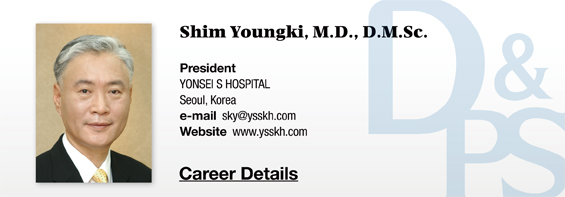Indications
Indications of sclerotherapy can be divided into cosmetic goals and therapeutic goals. Therapeutic goals include hemodynamic activation of lower limbs and improvement of localized skin changes (trophic skin disorder) secondary to varicose veins. Sclerotherapy improves venous reflux thereby accelerating the healing process of skin ulcer and eczema. Cosmetic goals apply to all cases of varicose veins. In particular, spider veins or reticular varices with minimal hemodynamic changes are the most common indications of sclerotherapy.
During pregnancy, prevention of deterioration with compression stockings is preferred to aggressive treatment of varicose veins. In some cases, varicose veins appear to have completely or partially disappeared after child birth, however, this is temporary improvement. It is advisable to treat with sclerotherapy or surgery following accurate diagnosis after child birth. Localized skin conditions such as severe dermatitis or ulcer can affect the fetus in some cases and treatment should be carried out during pregnancy. Experienced vascular surgeons say that treatment of varicose veins after second trimester has little impact on the fetus.
[Advertisement] MAGNUM(Q-switched Nd:YAG Laser) – Manufacturer: (www.i-dana.com)]
Table 2. Indications for sclerotherapy.
ⓐ Cosmetic indications
- mainly spider veins and varices lacking hemodynamic relevance
ⓑ Medical indications
- varices with hemodynamic relevance
- eczema in a varicose region
- dermatoses in the sense of an isomorphic irritant effect in the varicose (lichen ruber, psoriasis vulgaris)
ⓒ Restricted indications
- retromalleolar varices
- varicosis in pregnancy
- vulval varicosis
Contraindications
a. Pregnancy
Sclerotherapy performed during pregnancy carries the risk of the drug being absorbed by the fetus. The entire venous system is relaxed during pregnancy and three months after child birth due by various mechanisms. Despite successful sclerotherapy, physiological mechanisms opposing vascular fibrosis and recession, goals of sclerotherapy, can occur in pregnancy and childbirth. It is, therefore, best to postpone the treatment in pregnant women. In about 2% of patients, varicose veins develop in the vulva, most likely in the second trimester and in pluriparous women. The pain intensifies during ambulation but thrombosis is unlikely.
b. Patients with limited mobility
Waling after treatment is very important as it can rapidly dilute the sclerosing agent before it can enter deep veins. Muscle contraction thrombolytic substances are released and prevents severe thrombosis and stagnant blood. It also reduces vasodilation arising from reflux. However, immobile patients have a higher risk of complications from thrombus formation following injection of the slcerosing agent and are not eligible for sclerotherapy.
c. Patients with history of thrombophlebitis or deep vein thrombosis
d. Allergic reaction
e. Patients treated with disulfiram
Contraindiations chart
Contraindications, absolute
bedridden patients
3rd or 4 th occlusive arterial disease
known allergy to sclerosing agent
Contraindications, relative
superficial and especially in deep vein thrombosis
severe edema of the leg
diabetic microangiopathy
severe acute heart disease
febrile state
2nd occlusive arterial disease
elderly patients with limited mobility or very poor general condition
bronchial asthma
pregnancy, in the first trimester and after the 36th week of pregnancy
-To be continued-





















